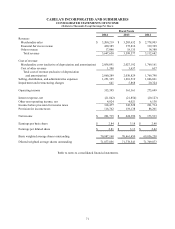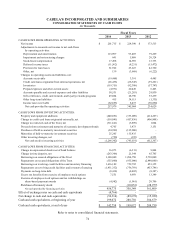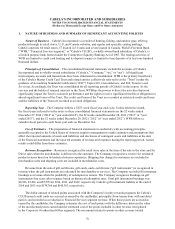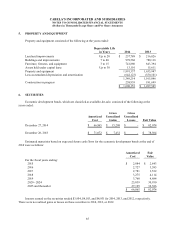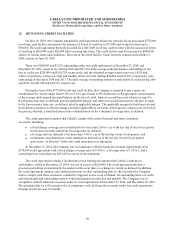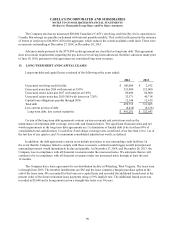Cabela's 2014 Annual Report Download - page 90
Download and view the complete annual report
Please find page 90 of the 2014 Cabela's annual report below. You can navigate through the pages in the report by either clicking on the pages listed below, or by using the keyword search tool below to find specific information within the annual report.80
CABELA’S INCORPORATED AND SUBSIDIARIES
NOTES TO CONSOLIDATED FINANCIAL STATEMENTS
(Dollars in Thousands Except Share and Per Share Amounts)
the Company will adjust the deferred grant income to appropriately reflect the change in estimate and, at that
time, will record a cumulative additional depreciation charge that would be recognized to date as expense in the
absence of the grant income. In 2012, deferred grant income was reduced by $5,030 due to other than temporary
impairment losses of the same amount that were recognized on the Company’s economic development bonds.
These reductions in deferred grant income resulted in an increase in depreciation expense of $1,309 in 2012, which
was included in impairment and restructuring charges in the consolidated statements of income. There were no
impairment losses in 2014 and 2013. At the end of 2012, the cumulative amount of impairment adjustments that
were made to deferred grant income, which was recorded as a reduction of property and equipment, was $38,656.
There were no other than temporary impairments in 2014 relating to economic development bonds. The Company
may agree to guarantee deficiencies in tax collections which fund the repayment of economic development bonds.
The Company did not guarantee any economic development bonds that it owned at the end of 2014, 2013, or 2012.
Land grants typically include land associated with the retail store and may include other land for sale and
further development. Land grants are recognized at the fair value of the land on date of grant. Deferred grant
income on land grants is recognized as a reduction to depreciation expense over the estimated life of the related
assets of the developments. The Company did not receive any land grants in 2014 or 2013. At December 28, 2013,
the Company recognized a liability to repay grants related to a retail store property. The adjustments that reduced
the deferred grant income of this retail store property resulted in an increase in expense of $831 and $4,931 in 2014
and 2013, respectively.
Certain grants contain covenants the Company is required to comply with regarding minimum employment
levels, maintaining retail stores in certain locations, and maintaining office facilities in certain locations. For these
grants the Company recognizes grant revenue as the milestones associated with the grant are met. For 2014 and
2013, the Company was in compliance with the requirements under these grants.
Economic Development Bonds – Economic development bonds are related to the Company’s government
economic assistance arrangements relating to the construction of new retail stores or retail development. Economic
development bonds issued by state and local municipalities are classified as available-for-sale and recorded at
their fair value. Fair values of bonds are estimated using discounted cash flow projections based on available
market interest rates and management estimates including the estimated amounts and timing of expected future
tax payments to be received by the municipalities under development zones. These fair values do not reflect any
premium or discount that could result from offering these bonds for sale or through early redemption, or any
related income tax impact. Declines in the fair value of available-for-sale economic development bonds below cost
that are deemed to be other than temporary are reflected in earnings.
On a quarterly basis, we perform various procedures to analyze the amounts and timing of projected cash
flows to be received from its economic development bonds. We revalue each economic development bond using
discounted cash flow models based on available market interest rates (Level 2 inputs) and management estimates,
including the estimated amounts and timing of expected future tax payments (Level 3 inputs) to be received by the
municipalities under tax increment financing districts. Projected cash flows are derived from sales and property
taxes. Due to the seasonal nature of the our business, fourth quarter sales are significant to projecting future cash
flows under the economic development bonds. We evaluate the impact of bond payments that have been received
since the most recent quarterly evaluation, including those subsequent to the end of the quarter. Typically, bond
payments are received twice annually. The payments received around the end of the fourth quarter provide the
Company with additional facts for its fourth quarter projections. We make inquiries of local governments and/or
economic development authorities for information on any anticipated third-party development, specifically on land
owned by the Company, but also on land not owned by the Company in the tax increment financing development
district, and to assess any current and potential development where cash flows under the bonds may be impacted by
additional development and the anticipated development is material to the estimated and recorded carrying value
based on projected cash flows. We make revisions to the cash flow estimates of each bond based on the information
obtained. In those instances where the expected cash flows are insufficient to recover the current carrying



